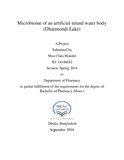Microbiome of an artificial inland water body (Dhanmondi Lake)

View/
Date
2018-09Publisher
BRAC UniversityAuthor
Mondol, Mou ClaraMetadata
Show full item recordAbstract
Water is essential for life but it can also be a source of various human related diseases if it is contaminated by microscopic organisms. The study was conducted to isolate and characterize gram-negative bacteria isolates present in lake water used by humans. Water sample was collected from Dhanmondi Lake of Dhaka in a 250 ml of Duran bottle. After the sample collection 20ml of water sample was mixed in nutrient broth for the pre-enrichment of microorganisms. When culture was observed in nutrient broth a loopful of enriched culture was streaked into MacConkey agar plate for the separation of gram-negative bacteria. Total twenty-four bacterial colonies were selected from the MacConkey plate that were further characterized by observing their morphology and by performing biochemical tests which included “Indole test, Methyl Red test, Voges-Proskauer test, Citrate test, Kligler’s Iron agar test and Motility test”. After performing the entire test, it was found that among twenty-four isolates 41.66% was E. coli, 29.16% was Klebsiella, 8.33% was Pseudomonas, 8.33% was Shigella, 8.33% was Citrobacter and only 4.16% was Enterobacter. PCR method can be used for the precise detection of the species of this organism. Following the study, the desire is to become aware about the presence of these bacteria in water and ensure a safe use of water.
